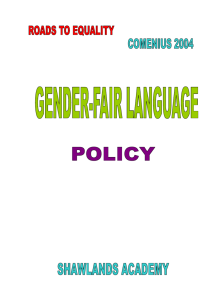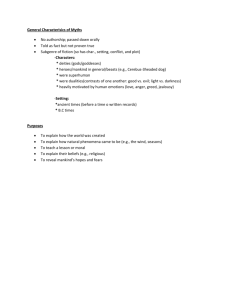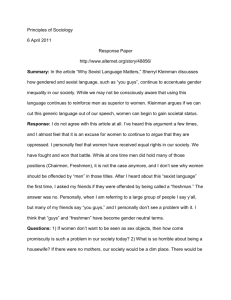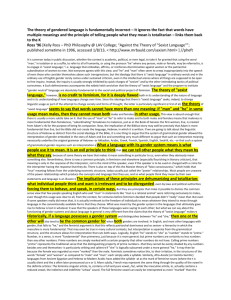The Extinction of Masculine Generics
advertisement
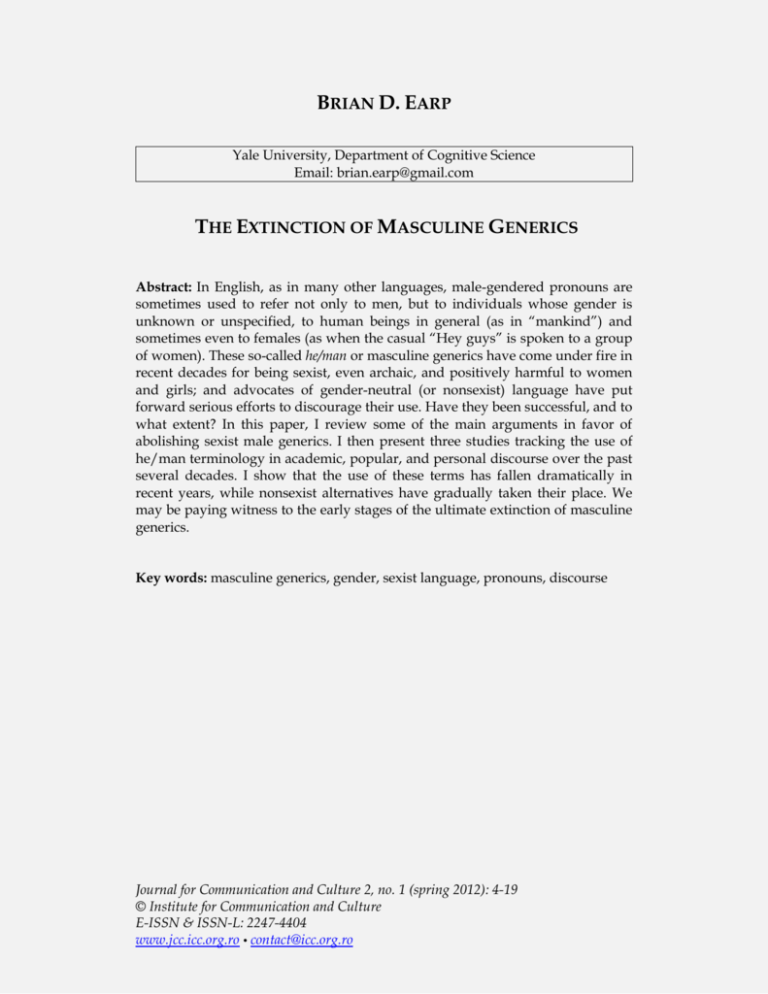
BRIAN D. EARP Yale University, Department of Cognitive Science Email: brian.earp@gmail.com THE EXTINCTION OF MASCULINE GENERICS Abstract: In English, as in many other languages, male-gendered pronouns are sometimes used to refer not only to men, but to individuals whose gender is unknown or unspecified, to human beings in general (as in ―mankind‖) and sometimes even to females (as when the casual ―Hey guys‖ is spoken to a group of women). These so-called he/man or masculine generics have come under fire in recent decades for being sexist, even archaic, and positively harmful to women and girls; and advocates of gender-neutral (or nonsexist) language have put forward serious efforts to discourage their use. Have they been successful, and to what extent? In this paper, I review some of the main arguments in favor of abolishing sexist male generics. I then present three studies tracking the use of he/man terminology in academic, popular, and personal discourse over the past several decades. I show that the use of these terms has fallen dramatically in recent years, while nonsexist alternatives have gradually taken their place. We may be paying witness to the early stages of the ultimate extinction of masculine generics. Key words: masculine generics, gender, sexist language, pronouns, discourse Journal for Communication and Culture 2, no. 1 (spring 2012): 4-19 © Institute for Communication and Culture E-ISSN & ISSN-L: 2247-4404 www.jcc.icc.org.ro • contact@icc.org.ro Brian D. Earp Introduction The history of the English language is stuffed full of male-gendered terms used in reference not just to men, but to human beings in general, or to persons of unspecified gender. From the New Testament, for instance, we learn that Jesus rebuked his tempter with ―Man does not live on bread alone...‖ 1 ; from Hamlet‘s existential musings we get ―What a piece of work is a man...‖2; the US founding fathers held as self-evident that ―all men are created equal...‖3; and Neil Armstrong famously botched his ―one small step for [a] man; one giant leap for mankind‖ 4 remark via live broadcast from the moon. From my own experience, I can report that as recently as the late1990s, at least some students (namely I and my middle-school peers) were still being taught to use ―he‖ to refer anyone whose sex was unknown, or to hypothetical or generic persons in sentences such as the following: ―When you meet your new doctor, be sure to tell him about your bad back‖; ―If a person loses his wallet, he should visit the lost-and-found‖; ―Everyone should take his seat when the bell rings,‖ and so on. These socalled he/man or masculine generics5 (or quasi-generics6) – as ubiquitous and deeply rooted as they are – are instances of sexist language that many have argued are harmful to women and should be expunged from the linguistic repertoire. I am sympathetic with this view; and I am interested to see whether, in light of decades of feminists‘ efforts at consciousness-raising and language-change, there is evidence that this expunction is actually taking place. Accordingly, this paper consists of two parts. In the first part, to provide some background, I review some of the main arguments in favor of abolishing sexist male quasi-generics. In the second part, I present three studies, each of which provides empirical evidence that (at least some) he/man terminology may indeed be on its way out. In the first study, I tracked the number of scholarly articles over a thirty-year period (1970- 2000) in which various gendered pronouns occur, using the popular academic archives service JSTOR.7 I show that instances of the sexist term mankind fall significantly over this period, while instances of the gender-inclusive term humankind and the construction he or she rise dramatically. In the second study, I tracked these terms‘ occurrences (by number of articles) over the same period in The New York Times, with similar results. In the third study, I replicated a survey on pronoun usage first conducted by Miriam Meyers in 1990 in order to compare her results with a more recent sample. I find evidence that pronoun use in the more recent sample may be even less sexist than in the 1990 sample. Journal for Communication and Culture 2, no. 1 (spring 2012) 5 The Extinction of Masculine Generics Part 1: The Case against He/Man Language—A Very Brief Review The use of masculine terms to refer to persons of unknown gender, generic or hypothetical persons, people in general, or as a synonym for humankind is more than just a grammatical curiosity. As a number of commentators8 have forcefully argued, it may be legitimately harmful to women and girls. One way to understand this harm is to consider how masculine generics (such as mankind) seem to count being a man as the default or prototypical human status, creating what Wendy Martyna calls an ―implicit equation of maleness with humanness.‖9 This equation has the effect of devaluing, excluding, or making invisible female human beings – a matter of particular concern since, as Michael Newman points out, females ―not only constitute half of humanity, but are also victims of other forms of marginalization.‖10 Non-sexist terms such as humankind, that is, terms which embrace – both denotatively and connotatively – all genders, nimbly avoid this problem and are thus preferable to their sexist counterparts. What does it mean for masculine terms to make women ―invisible‖ – and how could mere word-choice have such a dramatic-sounding effect? Simply put, there is ample psycholinguistic evidence 11 that people encountering he/man generics are more likely to think of male human beings as the referents of those terms. Thus, when a person reads or hears the word ―mankind,‖ for example, he or she is likely to reflexively conjure up mental images of men (doing such-and-so) as opposed to either women or abstract visions ―the human race.‖ This has the effect of minimizing women‘s importance and diverting attention away from their very existence.12 The result is a sort of invisibility – in the language itself, in the individual‘s mind‘s eye, and in the broader social consciousness. Someone could object that metaphorical ―invisibility‖ is too gauzy a notion to merit serious concern. But sexist language has consequences in the real world as well. For example, Sandra Bem and Daryl Bem found evidence that ―sex-biased wording in job advertisements ... discourage[d] ... women from applying for ‗opposite-sex‘ jobs for which they might well be qualified.‖13 And more recently, John Briere and Cheryl Lanktree found that subjects who had been exposed to various levels of sexist noun and pronoun usage rated the attractiveness of a career in psychology in ―sexrole stereotypic directions as a function of degree of exposure to sexist language.‖ 14 Far from being ―gauzy‖ issues, job prospects and careerchoice are of practical concern and paramount importance. Sexist language which may have the effect of limiting a woman's options in these domains, then, is clearly harmful. In this very brief review, I have shown how he/man generics may be considered detrimental from the perspective of several different modes of Journal for Communication and Culture 2, no. 1 (spring 2012) 6 Brian D. Earp thought: philosophical, sociological, psychological, and practical. On this view, any evidence that such language use is on the decline would be most welcome. I turn now to the second part of my paper, in which I present three studies offering an empirical evaluation of just such a decline. Part 2: Three Studies Since at least the early 1970s, feminist linguists such as Wendy Martyna, Carolyn Korsmeyer, Janice Moulton, and others (see endnote 8) have made compelling arguments against the use of he/man language, advocating its abolition wherever it may be found. Has anyone been listening? Have there been any changes in sexist language use over the past thirty (or so) years? Following are three studies, designed to address this question from three different angles—that is, by generating data from three different domains of language-use: ―academic,‖ ―popular,‖ and ―personal.‖ Each points towards a ―yes‖ in answer to the question above. In the first study, to examine academic or scholarly writing, I tracked the number of JSTOR articles over a thirty-year period (1970 – 2000) in which the pronouns mankind, humankind, and the construction he or she occur. In the second study, to examine a more ―popular‖ medium, I tracked these terms‘ occurrences (by number of articles) over the same period in The New York Times. In the third study, I replicated a survey on pronoun usage by college-educated individuals first conducted by Miriam Meyers in 1990 in order to compare her results with a more recent sample. Study #1: Gendered Terms and JSTOR 1970 – 2000 JSTOR is a popular online digital archive of scholarly articles from a wide array of disciplines. Its archives include ―over one thousand leading academic journals across the humanities, social sciences, and sciences‖ and is ―full-text searchable‖ including ―search term highlighting,‖ 15 making it an ideal data set for the purposes of the present research.16 Using JSTOR‘s own search technology, I tracked the number of occurrences (by article count) of a sample of three gendered terms over the period of 1970 – 2000. Method, Materials, and Procedure Materials used were the archives of scholarly articles located at http://www.jstor.org/ as well as JSTOR‘s ―advanced search‖ function. For each term included in the study (mankind, humankind, and he or she), I conducted an advanced search on the following model: [("mankind") AND (YEAR: [1970 to 1971])] Journal for Communication and Culture 2, no. 1 (spring 2012) 7 The Extinction of Masculine Generics I then recorded the number of articles returned, and repeated this search paradigm for each year from 1970 – 2000. Since a number of journals have a ―moving wall‖ of up to 5 years during which their articles are not available on JSTOR, I selected the year 2000 as a cut-off point to ensure maximum consistency of total available articles per year. While some new journals have been established since 1970, and while some old journals have expired since 1970, an informal survey of the available data suggests that these factors approximately balance out. Before turning to the results, let me give a note on my choice of search terms. I chose mankind as a quintessential he/man generic, and one likely to be found in academic writing of all stripes. I chose humankind as the direct gender-neutral counterpart of this term, to see how these nearsynonyms (one sexist, one non-sexist) would track against each other over the same thirty-year period. Finally, I chose the construction he or she as an additional gender-inclusive term, but one which plays a different linguistic role-specifically by referring to generic or hypothetical persons, and persons of unknown gender, as opposed to abstract entities such as ―all of humanity‖ (as with humankind). I would like to have been able to track instances of quasi-generic he; however, JSTOR‘s search technology is not sensitive enough to distinguish between quasi-generic instances of the term (―When a person loses his wallet, he should...‖) and specific instances of the term (―When Bob lost his wallet, he...‖). Contrastingly, he or she (used properly – that is, excluding instances of hypercorrection) is employed exclusively as a generic, referring to a person whose gender is unknown or unspecified, and can thus be reliably tracked via search technology. Results The data show a marked decline in the number of scholarly articles in a broad sample of over 1,000 leading journals in which the sexist term mankind occurs over a thirty year period (1970- 2000): from 3,149 instances in 1970- 1971 to only 1,929 instances in 1999- 2000, or a decrease of 38.8%. Over this same period, instances of the gender-neutral near-synonym, humankind, rose from only 63 articles in 1970- 1971 to 1,192 articles in 19992000, an increase of 1,890%. Finally, article-instances of the genderinclusive he or she rose in this period from 340 to 4,062, an increase of 1,194%. Below are the data in tabular form (Table 1). Year 1970-1971 1971-1972 1972-1973 1973-1974 1974-1975 mankind 3149 3143 3099 3125 3122 humankind 63 64 76 128 187 Journal for Communication and Culture 2, no. 1 (spring 2012) he or she 340 420 559 878 1255 8 Brian D. Earp 1975-1976 1976-1977 1977-1978 1978-1979 1979-1980 1980-1981 1981-1982 1982-1983 1983-1984 1984-1985 1985-1986 1986-1987 1987-1988 1988-1989 1989-1990 1990-1991 1991-1992 1992-1993 1993-1994 1994-1995 1995-1996 1996-1997 1997-1998 1998-1999 1999-2000 3158 3061 2968 2986 2914 2862 2883 2875 2787 2732 2668 2519 2548 2605 2505 2469 2377 2306 2164 2022 2048 2022 1957 1961 1929 246 289 314 357 395 440 480 535 635 752 753 714 762 836 939 998 1070 1136 1174 1248 1249 1235 1249 1182 1192 1609 1990 2265 2495 2742 2811 2897 3064 3205 3381 3485 3557 3696 3879 4118 4176 4140 4235 4266 4322 4324 4295 4258 4131 4062 Table 1: Gendered Terms and JSTOR 1970 – 2000 Discussion These results provide clear empirical evidence that at least one sexist masculine generic – mankind – has been in steady decline in language-use over the past thirty years, specifically within the domain of academic writing (across disciplines). At the same time, the use of humankind – a gender-inclusive near-synonym – has grown in popularity quite dramatically, from a mere 63 instances in 1970-1971 (compared to 3,149 instances of mankind during the same period), to 1,192 in 1999-2000. It is important to notice, however, that even as recently as the year 2000, mankind appeared in more total articles (by 38.2%) than its nonsexist counterpart. Nevertheless, one need not conclude that the sexist term is used more frequently than its non-sexist alternatives: after all, humankind is only one of a number of gender-inclusive synonyms (or nearsynonyms): in addition, there are terms such as ―humanity‖ and ―the human race‖ which may be used instead of mankind but which were not tracked in this study. Taken together, it is possible that these non-sexist terms are used more frequently. Further research should bear this out.17 It is interesting to note that while humankind has been in use since 1635 18 as an alternative to mankind (dating from 1250 19 ), it was Journal for Communication and Culture 2, no. 1 (spring 2012) 9 The Extinction of Masculine Generics nevertheless almost completely absent from academic writing as late as the 1970s, with the sexist term evidently widely preferred. As my data show, however, this trend seems to have undergone major changes within the last thirty years. Finally, notice the explosion in use of the construction he or she after the year 1970. The idea, apparently hitherto only latent, that a person of unknown or unspecified gender might possibly be a female—and that such a possibility should be made linguistically explicit—seems to have caught on quite suddenly! Let me turn now to my second study, in which I shift from the domain of academic writing to that of a more popular medium, The New York Times. Study #2: Gendered Terms and The New York Times 1970 – 2000 The New York Times is widely recognized as the newspaper of record for the United States. Thus it is an excellent popular source to track nonacademic language usage. 20 In addition, the newspaper‘s searchable online archives (from 1851 to the present) located at http://www.nytimes.com/ provides ample – and easy-to-access – data, ideal for the purposes of the present study. In this study, I tracked the number of occurrences (by article count) of a sample of three gendered terms over the period of 1970-2000. Method, Materials, and Procedure Materials used were the online archives of New York Times articles, located at http://www.nytimes.com/ as well as the site‘s ―advanced search‖ function. For each term included in the study (mankind, humankind, and he or she), I conducted an advanced search by typing the term in quotes in the search field, and setting the date range to, e.g., January 1st 1970 to January 1st 1971. I then recorded the number of articles returned, and repeated this search paradigm for each year from 1970 – 2000, recording the data in an Excel worksheet for later analysis. Results The data show a significant decline in the number of New York Times articles in which the sexist term mankind occurs over a thirty year period (1970-2000): from 461 instances in 1970-1971 to only 159 instances in 19992000, or a decrease of 65.5%. Over this same period, instances of humankind rose from only 6 articles in 1970-1971 to 76 articles in 1999-2000, an increase of 1,266%. Finally, article-instances of the gender-inclusive he or she rose in this period from 43 to 346, an increase of 804%. These results are shown in tabular form below (Table 2). Journal for Communication and Culture 2, no. 1 (spring 2012) 10 Brian D. Earp Year 1970-1971 1971-1972 1972-1973 1973-1974 1974-1975 1975-1976 1976-1977 1977-1978 1978-1979 1979-1980 1980-1981 1981-1982 1982-1983 1983-1984 1984-1985 1985-1986 1986-1987 1987-1988 1988-1989 1989-1990 1990-1991 1991-1992 1992-1993 1993-1994 1994-1995 1995-1996 1996-1997 1997-1998 1998-1999 1999-2000 mankind 461 393 429 404 376 389 396 328 252 312 252 285 277 237 227 307 265 231 172 176 169 179 121 120 124 125 128 115 171 159 humankind 6 6 16 15 21 36 29 24 26 30 26 48 53 32 44 58 60 49 40 46 51 45 46 59 46 53 62 66 81 76 he or she 43 85 138 147 166 259 296 331 277 296 306 357 295 317 368 368 395 340 353 345 330 307 296 319 299 314 337 326 337 346 Table 2: Gendered Terms and The New York Times 1970 – 2000 Discussion The purpose of this second study was to extend the results of Study #1 into a domain other than strictly academic writing, namely the more ―popular‖ medium of journalism and news articles. In a remarkably similar trend (as compared to the first study), the results of the present study provide clear empirical evidence that mankind has been in steady decline in language-use over the past thirty years—not only in academic, but in non-academic writing as well. At the same time, the use of humankind has grown in popularity from a mere 6 instances in 1970 – 1971 (compared to 461 instances of mankind during the same period), to 76 in 1999 – 2000. The striking similarity in term-use trajectories (including he or she) between Studies #1 and #2 merits further consideration. On the one hand, Journal for Communication and Culture 2, no. 1 (spring 2012) 11 The Extinction of Masculine Generics someone might predict that sexist language would decline in academic usage significantly prior to popular usage, since the former is thought to be more deliberately, philosophically motivated (and thus particularly susceptible to the feminist‘s arguments coming out of the early 1970s), while the latter reflects more non-intellectual sociolinguistic movements. On the other hand, someone could argue that academic language is more conservative and thus less prone to change, while popular language evolves at a much faster rate, absorbing new terminology (for example, in the form of slang) far in advance of academic adoption of those terms. But seemingly both predictions would fail: the movement towards less sexist (or more gender-inclusive) language seems (at least with regard to the examples tracked by the present studies) to have taken place along a similar trajectory in both academic and more popular writing. Let me turn now to a third study, which attempts to replicate a survey conducted in 1990 by Miriam Meyers on sexist language in writing samples of individual adults subjects. This will ―complete the picture‖ of this essay‘s intended scope, giving evidence for language-change on a third and final dimension—the ―personal‖ dimension. Study #3: Gendered Terms in "Personal" Writing, 1990 vs. 2008 The design of this third study departs drastically from that of Studies #1 and #2. It is modeled on a study conducted by Miriam Meyers,21 who was interested in the ways in which college-educated adults approached writing about a person of unspecified gender. In her study, participants were asked to describe their idea of ―the educated person‖ as part of their student degree plans concerning enrollment at an unreported Minnesota university (probably Metropolitan State, given Meyers‘ affiliation). Meyers then coded responses for their use of various third-person singular generic pronouns. Her results showed that, among writers using a consistent strategy, 34% used the generic masculine (e.g., ―My idea of an educated person [is of one who] has learned the skills to educate himself in unknown areas...‖); 32% used singular they (e.g., ―I see an educated person as [one who] uses their knowledge...‖); 22% used a he or she type construction (e.g., ―The educated person does not overlook his/her chosen profession...‖); 8% used indefinite one (e.g., ―The educated person [is] one who has a curiosity and open mind...‖); and 4% used the generic feminine (e.g., ―An educated person [is] aware of who she is...‖). These results can be seen in Table 3, below. Journal for Communication and Culture 2, no. 1 (spring 2012) 12 Brian D. Earp Generic Masculine Singular they he/she one Generic Feminine 34% 32% 22% 8% 4% Table 3: Choice of Writers Using a Consistent Singular Approach to the Generic Pronoun, Adapted from Meyers (1990) In the present study, participants were asked to describe their idea of ―The Moral Individual‖ under the pretense that their responses would be used in a future study on moral judgment (thus concealing the sociolinguistic nature of the actual study). The methods and results for this study follow. Method, Participants, Materials, and Procedure Participants were 64 adults (27 male, 36 female, 1 unspecified)22 ranging in age from 18 to 74 years, with a mean age of 26 and a mode age of 21.23 The majority of participants were college students enrolled at Yale University in New Haven, CT; all had at least 2 years of college.24 Participants were acquainted with the author of the present study but not with his research aims; an invitation to participate was sent (via email) to 137 such acquaintances; the 64 who responded by filling out an online survey were included in the study. These data were collected in 2008. Participants were directed to and asked to fill out an online survey (posted on www.surveymonkey.com). They were asked to ―Please describe in 3-5 sentences below your conception of The Moral Individual‖ and to do so in no fewer than 3 and no more than 5 sentences. They were asked to write in complete, grammatical sentences, and to start the first sentence with ―The Moral Individual is‖ and proceed from there. Demographic information was then collected. Participants‘ responses were then coded for pronoun usage according to the same categories used by Meyers, namely (1) the generic masculine, (2) singular they, (3) he or she type treatments (including she or he and s/he), (4) the generic feminine (she standing alone), (5) indefinite one, (6) an inconsistent mix, and (7) ―other‖ (including the use of no pronouns, pluralization of the subject, and the one-time use of a generic pronoun such that consistency could not be judged). Results 27 respondents (42%) either used an inconsistent mix of pronouns, used only one pronoun such that consistency could not be judged, or avoided the use of pronouns altogether. Of the 37 remaining respondents, 10 used the generic masculine 7 used singular they 13 used he or she type treatments Journal for Communication and Culture 2, no. 1 (spring 2012) 13 The Extinction of Masculine Generics 5 used the generic feminine, and 2 used indefinite one Of those who used a consistent singular approach to the generic pronoun, then, 27% used the generic masculine 19% used singular they 35% used he or she type treatments 13.5% used the generic feminine, and 5.5% used indefinite one Compare these results with those of Meyers (1990) (my results in bold): Generic Masculine Singular they he/she one Generic Feminine 34% 32% 22% 8% 4% 27% 19% 35% 5.5% 13.5% Table 4: Comparison of Choice of Writers Using a Consistent Singular Approach to the Generic Pronoun in Meyers (1990) and the Present Study Discussion Although statistical significance cannot be calculated across two different populations (i.e., between the sample group used in Meyers‘ study and the sample group used in the present study), an informal analysis of the above data suggests that the more recent sampling of current generic pronoun usage may be even less male-sexist than the sampling taken in 1990, itself almost certainly an improvement over earlier populations (given the data from the 1970s in Studies #1 and #2). One major difference is that in the 1990 study, the sexist masculine generic was the most frequently used construction, while in the present study, the non-sexist he or she treatment was most commonly used. In addition, in the present study, fully 13.5% of consistent pronoun-users employed the generic feminine25 (compared to only 4% in the 1990 study) and 35% used the gender-neutral he or she construction (compared to 22% in 1990). Interestingly, in both studies, approximately 1/3 of respondents elected to use the sexist male generic (34% in 1990; 27% in 2008), while the singular they—thought to be a popular non-sexist choice—was used much less frequently in the present study as compared to the earlier one (19% compared to 32%). It should be noted, however, that in the present study, singular they was used in combination with other pronouns in the ―inconsistent mix‖ category somewhat frequently. Fully 18 out of the 64 total respondents (or 28.1%) used the singular they construction at least once. Furthermore, in the present study, the masculine generic was overrepresented among consistent pronoun users (the sub-group of total respondents upon which the present analysis is chiefly based), while Journal for Communication and Culture 2, no. 1 (spring 2012) 14 Brian D. Earp among mixed- and ―other‖-pronoun users, only 3 of 23 or 13% used a masculine generic at least once, and fully 20 of 23 or 87% used nonsexist pronoun strategies. Before turning to a general discussion, a potential confound must be noted in comparing the Meyers (1990) study and the present study. The confound has to do with the different ―primes‖ used to generate the writing samples in each respective study. In the Meyers study, participants were asked to describe ―the educated person‖ while in the present study, participants were asked to describe ―the moral individual.‖ Although each of these prompts was designed to test subjects‘ handling of pronouns referring to a hypothetical person of unspecified gender, it is possible that implicit gender stereotypes ―nudged‖ pronoun usage in different directions between the two studies, on account of the different primes. ―The educated person‖ is, it could be argued, more likely to be implicitly stereotypically associated with males (given the long history of women‘s exclusion from schooling), while ―the moral individual‖ could be implicitly stereotypically associated more with females (given, for instance, the stereotype that mothers are more concerned with the moral upbringing of their children than fathers). Further research would be needed to test this assumption. General Discussion I began by reviewing a number of arguments to the effect that the sexist male quasi-generics typical of he/man language are harmful to women and ought to be avoided where possible. While some resist this view, sometimes citing the ―awkwardness‖ of alternative constructions (such as ―he or she‖), it is becoming more and more widely accepted. This acceptance is heavily driven by psycholinguistic evidence which shows that he/man grammar is not a mere curio of convention: these words have measurable (deleterious) effects on the listener, especially females, both in terms of the implicit messages they convey, and the consequences they carry for issues as weighty as choice of career. If masculine generics can be avoided, they should be avoided; and they can always be avoided – with a bit of creative thinking. But to move beyond the abstractions of the academic dispute, what has been the real-world impact of the feminists‘ case on this issue? I presented three studies designed to test empirically whether, over the past thirty years, the use of masculine generics has actually seen a decline. Across three domains – academic, popular, and personal – the results are clear: he/man language is increasingly less used, and nonsexist alternatives are on the rise. Curiously, so is the use of female-sexist pronouns – the generic ―she‖ or ―her‖ – which can be interpreted in a number of different ways. On the Journal for Communication and Culture 2, no. 1 (spring 2012) 15 The Extinction of Masculine Generics one hand, it could be argued that fighting sexist pronoun use with equally sexist pronoun use amounts to hypocrisy, and hence gender-neutral terms (such as ―they‖ or ―he or she‖) should be used wherever possible. But on the other hand, perhaps the deliberate use of ―she‖ to refer to unspecified individuals, or to persons of unknown gender, can be seen as an important consciousness-raising exercise, a temporary effort to ―make the point‖ about generic masculine pronoun use in a particularly salient, instantly graspable way. There is obviously no objectively ―correct‖ way to think about it, but given the hundreds of years of lopsided, malefavoring language use (in a broader context of male-favoring power structures, male-favoring legal doctrines, male favoring social norms, etc.), it seems justifiable to add some weight to the other side of the scale, at least to the point of equilibrium. Whether the trends identified in this article continue, only time will tell; but if they do, we may be well on our way to seeing the ultimate extinction of masculine generics in the English language. It would be about time. Notes: Matthew 4:4, New International Version. Hamlet II.ii.317. Though this phrase is often cited as a stock example of he/man language in feminist and linguistic texts, it is actually unclear, in context, whether Hamlet‘s ―a man‖ is synonymous with ―a human being‖ and thus a true male quasi-generic. Hamlet goes on to characterize ―a man‖ as ―this quintessence of dust‖ which alludes specifically to Adam, the symbolic progenitor of males in particular, and not to Eve, who was formed (as the story goes) from Adam‘s rib rather than from dust. The matter is further complicated by the fact that in popular recitation, the phrase is often misquoted as ―what a piece of work is man‖—without the article a—which gives the term a stronger gloss of ―genericness‖ than is warranted by the original text. Finally, consider the end of the speech and the ensuing exchange with Rosencrantz: 1 2 Hamlet: What a piece of work is a man... ...And yet, to me, what is this quintessence of dust? Man delights not me – nor woman neither, though by your smiling you seem to say so. Rosencrantz: My lord, there was no such stuff in my thoughts. Hamlet: Why did you laugh, then, when I said ―man delights not me‖? Rosencrantz: To think, my lord, if you delight not in man, what lenten entertainment the players shall receive from you... [Hamlet II.ii.317-329] It is unclear whether Hamlet intends for ―man‖ to refer generically to human beings and only clarifies by adding ―nor woman neither‖ because he is misunderstood (or is being teased by) Rosencrantz, or whether the contrast with Journal for Communication and Culture 2, no. 1 (spring 2012) 16 Brian D. Earp ―woman‖ should be taken at face value as evidence of a narrower intended referent for ―man.‖ 3 The Declaration of Independence. It is a matter of controversy whether Jefferson had all human beings in mind when he penned this phrase, or, given the political disenfranchisement of women at the time, whether he meant just all males. This historical point notwithstanding, however, the term is understood today (both legally and popularly) in its wider – that is, quasi-generic – sense. It is interesting to note the conscious effort to avoid similar confusion by the authors of two documents modeled on the Declaration: the women‘s-rights Declaration of Sentiments of 1848 (―all men and women are created equal...‖), and the Universal Declaration of Human Rights of 1948 (―all human beings are born free and equal...‖). The second of these is arguably even less sexist than the first, for it does away with a male-first ordered pair. 4 But see Mark Carreau, ―One small step for clarity: Researcher discovers that Neil Armstrong had not only the right idea but the right words‖ in The Houston Chronicle, September 30th 2006, accessed online April 7th, 2012 at http://www.chron.com/disp/story.mpl/front/4225856.html. 5 ―he/man‖ comes from Wendy Martyna‘s ―Beyond the He/Man Approach: The Case for Nonsexist Language‖ in Signs 5 (1983): 482-93. 6 ―quasi‖ because they cannot always replace bona fide gender-neutral terms, for example in sentences such as: ―Man is an animal who breastfeeds his young.‖ This sentence is awkward because of the inescapably masculine connotations of the term ―man.‖ 7 JSTOR (http://www.jstor.org/) is a popular digital archive of scholarly articles. It includes back issues of hundreds of the most popular academic journals. 8 e.g., Carolyn Korsmeyer, ―The hidden joke: Generic uses of masculine terminology‖ in Mary Vetterling-Braggin (Ed.) Sexist Language: A Modern Philosophical Analysis (New Jersey: Littlefield, Adams & Co., 1981); Wendy Martyna, ―Beyond the he/man approach: the case for nonsexist language‖ in Signs 5 (1983): 482-93; and Janice Moulton, ―The myth of the neutral ‗man‘‖ in Feminism and Philosophy, Ed. Frederick A. Elliston and Jane English. (Totowa, NJ: Littlefield, Adams, and Co., 1971), 124-153. 9 Martyna, ―Beyond the He/Man Approach: The Case for Nonsexist Language,‖ 32. 10 Michael Newman, Epicene pronouns: the linguistics of a prescriptive problem (New York: Garland Publishing, Inc, 1997), 4. 11 for recent examples see Jennifer Saul, ―Feminist philosophy of language‖ in The Stanford Encyclopedia of Philospohy (Winter 2007 edition), Edward N. Zalta (ed.), http://plato.stanford.edu/archives/win2007/entries/feminism-language/ (accessed April 7th, 2012); for research into the automaticity of sexist associations, see Mahzarin Banaji and Curtins Hardin, ―Automatic stereotyping‖ in Psychological Science 7, no. 3 (May 1996): 136-141; for a recent study see Elizabeth Wilson and Sik Hung Ng, ―Sex bias in visual images evoked by generics: A New Zealand Study‖ in Journal of Personality and Social Psychology 18, no. 3-4 (1988): 159-168. Journal for Communication and Culture 2, no. 1 (spring 2012) 17 The Extinction of Masculine Generics See Jennifer Saul, ―Feminist philosophy of language.‖ Sandra Bem and Daryl Bem, ―Does sex-biased job advertising ‗aid and abet‘ sex discrimination?‖ Journal of Applied Social Psychology 3, no. 1, (1973): 6. 14 John Briere and Cheryl Lanktree, ―Sex-role related effects of sex bias in language‖ in Behavioral Science 9, no. 5 (1983): 625. 15 ―The Organization,‖ accessed April 7th 2012 at http://about.jstor.org/aboutus/organization. 16 Other digital archives would in principle offer equally useful data; however JSTOR‘s search technology in particular is intuitive and easy to use, and its contents represent the most widely-read journals in a range of academic fields. 17 To compare: a quick, informal ―Google study‖ yields the following snapshot: 30,600,000 hits for mankind; 5,730,000 hits for humankind; 48,300,000 hits for humanity; 9,080,000 for human race. Thus, while mankind beats humankind, the aggregate of non-sexist terms (humankind, humanity, and human race) beat mankind by a large margin. 18 ―Humankind,‖ accessed April 7th 2012, http://dictionary.reference.com/browse/humankind. 19 ―Mankind‖ accessed April 7th 2012, http://dictionary.reference.com/browse/mankind. 20 As an anonymous reviewer on an earlier draft of this paper noted, many other newspapers might have served as an equally good case study; I chose the New York Times for its iconic status within as well as outside the U.S., and for its easyto-use online search technology. 21 Miriam Meyers, ―Current generic pronoun usage‖ in American Speech 65, no. 3, (1990): 228-237. 22 That is, 56% female. Compare to Meyers‘ sample: 55% female. 23 Compare to Meyers: n = 392, range = 22 – 64, mean = 34. 24 Consistent with Meyers. 25 As many have noted, the generic feminine is also sexist – but given the long history of masculine generics, it could be argued that the use of generic she is a legitimate part of the campaign to abolish he/man language (see the General Discussion). 12 13 References Banaji, Mahzarin, and Curtis Hardin. ―Automatic stereotyping.‖ Psychological Science 7, no. 3 (May 1996): 136 -141. Bem, Sandra, and Daryl Bem. ―Does sex-biased job advertising ‗aid and abet‘ sex discrimination?‖ Journal of Applied Social Psychology 3, no. 1 (1973): 6-18. Briere, John, and Cheryl Lanktree. ―Sex-role related effects of sex bias in language.‖ Behavioral Science 9, no. 5 (1983): 625-632. Carreau, Mark. ―One small step for clarity: Researcher discovers that Neil Armstrong had not only the right idea but the right words.‖ The Journal for Communication and Culture 2, no. 1 (spring 2012) 18 Brian D. Earp Houston Chronicle, September 2006. Accessed 10 May 2008, http://www.chron.com/disp/story.mpl/front/4225856.html. Dictionary.com. ―Humankind,‖ accessed April 7th 2012, http://dictionary.reference.com/browse/humankind. Dictionary.com. ―Mankind,‖ accessed April 7th, 2012, http://dictionary.reference.com/browse/mankind JSTOR. ―The Organization.‖ Accessed April 7, 2012. http://www.jstor.org/page/info/about/organization/index.jsp. Korsmeyer, Carolyn. ―The hidden joke: Generic uses of masculine terminology.‖ In Mary Vetterling-Braggin (Ed.) Sexist Language: A Modern Philosophical Analysis. New Jersey: Littlefield, Adams & Co, 1981. Martyna, Wendy. ―Beyond the he/man approach: the case for nonsexist language. Signs 5 (1983): 482-93. Meyers, Miriam Watkins. ―Current generic pronoun usage.‖ American Speech 65, no. 3 (1990): 228-237. Moulton, Janice. ―The myth of the neutral ‗man.‘‖ Feminism and Philosophy. Ed. Frederick A. Elliston and Jane English. Totowa, NJ: Littlefield, Adams, and Co., 1971. Newman, Michael. Epicene pronouns: the linguistics of a prescriptive problem. New York: Garland Publishing, Inc, 1997. Saul, Jennifer. Feminist philosophy of language. The Stanford Encyclopedia of Philosophy (Winter 2007 Edition), Edward N. Zalta (ed.), http://plato.stanford.edu/archives/win2007/entries/feminismlanguage/. Wilson, Elizabeth, and Sik Hung Ng. ―Sex bias in visual images evoked by generics: A New Zealand study.‖ Journal of Personality and Social Psychology 18, no. 3-4 (1988): 159-168. Journal for Communication and Culture 2, no. 1 (spring 2012) 19

